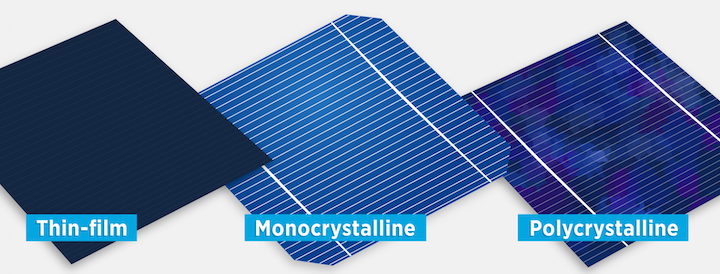solar power: A beginner’s guide
what are solar panels made of and how do they work
Solar cells are manufactured primarily from silicon, which has been used as an electrical component for decades due to its conductive properties. Silicon’s electrical characteristics change with exposure to light, creating an electric current. A cell is a small (i.e. 6″ x 6″) area of silicon with electrical contact plates on the face.

Solar panels are made by laying out a grid of these solar cells on a protective back sheet, and covering them on the front, sometimes with glass. Panels are typically manufactured in 60 and 72-cell configurations. It takes multiple solar panels to provide power to a home. Panels wired to the same inverter are a string of panels.
other parts of the solar energy system
To generate solar energy, you need an entire solar power system, which includes:
- Solar panels, which capture energy from the sun
- An inverter, which converts that energy into power we can use in the house
- Racking system, which supports the solar panels
- A battery, or method to store the energy you generate (unless you have a system that feeds power into the utility grid)
- Charge controller, which controls the rate at which batteries charge from solar
- Monitoring equipment to manage the system’s output online
what are potential draw backs of a home solar system
- High up front cost: Small systems cost a few thousand dollars, and larger systems for a family home can cost more than $10,000. While they typically pay off over the long run, it can be expensive to get started.
- Weather Dependent: Shade, leaves, snow, and other obstacles reduce the output of solar panels. If the panels don’t get a lot of sun, they don’t work effectively.
- Storage is expensive: Batteries are by far the most expensive part of a solar system. Consider just tying into the utility grid and going without a battery.
- Space: Solar panels still take up a lot of space, and you might need a few dozen panels for your home.
Grid-tie vs. off-grid solar systems
Unless you are living in a remote location, we recommend grid-tie systems. Grid-tie solar systems connect your solar panels to the existing utility grid, so you can sell energy back to the grid when you are not using it, and also allows you to get energy from the grid when the sun is not currently out. Grid-tie systems are cheaper to build than off-grid solar systems, and they save you money on your electric bill compared to buying electricity from your utility company. You still have the option of connecting a battery to a grid-tie system.
are solar panels worth the investment?
Solar energy costs less than you will pay your utility company for electricity, but you will need to pay for the solar panels and their installation. To calculate the break-even year, or time when the overall savings begins, you just need to complete some simple math.
The average cost of electricity is about $0.16 per kilowatt hour (kWh) of electricity. You can check your energy bill to find out your rate, and the amount of energy you use each month. As an example, if you use 1,000 kWh/month at $0.16/kWh, your bill comes to $160 each month, or $1,920 per year.
If you used our 8.28 kW system, which currently costs $11,999, it would cover 100% of the energy you use each month. The federal tax credit of 26% reduces your price to $8,879.26 plus taxes for the equipment. Assuming $400 to install your all-in cost is $9,279.26 plus taxes.
By generating your own power you get to keep $1,920 each year, so your break-even is after 5 years. This is known as the payback period, or how long it takes for your system to pay for itself. Because our panels are warrantied for 30 years, your system pays you back a minimum of 6 times your investment. Under this scenario, if you are going to own your house for at least 5 years, then solar energy makes financial sense.
other solar power information sources
Designing or selecting a solar power system can be complex. If you would like to further research the topic we recommend the following two resources that have a wealth of information on the subject:

